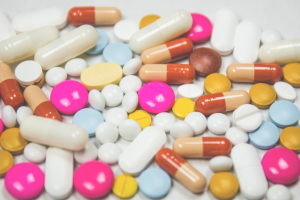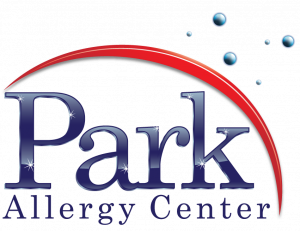Please check back with us for the latest news, announcements, and updates at Park Allergy Center! We regularly update our site with the latest allergy news and tips.
Over the past 5 years, most of the best allergy medications have gone from prescription only to over-the-counter. So, patients no longer need to go to a physician to receive good, basic treatment for nasal, eye, and skin allergy symptoms. However, there are a lot of options out there, so it can get confusing. I will try to clarify things for you.
There are 3 basic categories of OTC allergy medications: oral antihistamines, nasal steroid sprays, and oral decongestants. In today’s post, I will review antihistamines. In future posts, I will review nasal steroid sprays and oral decongestants.
Oral antihistamines are the most familiar type allergy medication to most people. Such medications include Benadryl, Claritin, Zyrtec, Xyzal, and Allegra. Like the name suggests, antihistamines block the effect of histamine – the primary substance involved in causing allergy symptoms. In general, antihistamines are effective in treating itch, sneeze, and drainage. They are not effective in treating nasal stuffiness.
For adults and larger children, I usually recommend Allegra (fexofenadine) 180mg daily as needed. This antihistamine is good, strong, and has the fewest side effects in the antihistamine class. For smaller children who cannot swallow pills, I usually recommend Claritin or Zyrtec. The dose depends on the size of the child and the clinical situation.
For mild allergies, antihistamines are a good first option. However, if they are not effective enough, you should try a steroid nasal spray – the topic of the next post coming soon.
Michael Park, MD
ARLINGTON HEIGHTS, IL – (APRIL 2, 2019) – Allergy shots (subcutaneous immunotherapy or SCIT) have been available for more than 100 years. Allergy tablets (sublingual immunotherapy or SLIT) have been approved by the Food and Drug Administration (FDA) for use in the United States for four years. A new study in Annals of Allergy, Asthma and Immunology, the scientific journal of the American College of Allergy, Asthma and Immunology (ACAAI) shows that most American allergists now prescribe the tablets for some patients to treat certain allergies. The study was developed by the ACAAI Immunotherapy and Diagnostics Committee.
“Five years ago, allergy tablets hadn’t been approved by the FDA and weren’t being prescribed for people with allergies in the U.S.,” said allergist Anita Sivam, DO, ACAAI member and lead author. “Allergists were prescribing allergy shots because they were, and continue to be, a proven effective treatment. Once allergy tablets were approved in 2014, allergists began prescribing them for their patients. Of the 268 US allergists who responded to our survey in 2018, 197 (73 percent) reported prescribing allergy tablets.”
Allergy tablets are available to treat northern grass pollens, Timothy grass pollen, ragweed and house dust mite. The northern grass pollens and the Timothy grass pollen tablets are both approved down to age 5 years and the other two for those 18 years and older. The tablets differ from allergy shots because after the first dose is given in an allergist’s office, they can be taken at home. The tablets are placed under the tongue and dissolve.
In immunotherapy, the regular administration of the allergen doses causes your immune system to become less sensitive to the allergen. Reducing your sensitivity reduces your allergy symptoms.
“One of the big differences between shots and tablets is that shots are formulated by your allergist to treat your specific allergy or allergies,” says allergist Mike Tankersley, MD, MBA, vice-chair of the ACAAI Immunotherapy and Diagnostics Committee and co-author of the study. “Tablets target a single allergy, and our study found that was the main barrier for allergists in prescribing tablets. If a patient has more than one allergy and is able to travel regularly to receive allergy shots, an allergist may recommend shots over tablets.”
Both shots and tablets – the only FDA-approved immunotherapy treatments for allergies – are successful because they work by changing your immune system. They decrease some cells, chemicals and antibodies in your system that cause allergy symptoms and increase others that improve health. Allergy shots and tablets allow you to encounter your allergens without having a reaction. Immunotherapy also reduces the inflammation that characterizes hay fever and asthma, so many sufferers find their symptoms improve.
To find an allergist near you who can help create a personal immunotherapy plan for your allergies or asthma and help you lead the life you want to live, use the ACAAI allergist locator.
Citation: https://acaai.org/news/new-research-shows-73-percent-allergists-prescribe-under-tongue-allergy-tablets?
Park Allergy Center provides both oral drops or tablets for allergy immunotherapy treatment.
If you sneeze and cough during certain times of the year, you may have seasonal allergies. However, occasional allergies aren’t something you just have to live with. An allergist can pinpoint the cause and help you find relief.
In many areas of the United States, spring allergies begin in February and last until the early summer. Tree pollination begins earliest in the year followed by grass pollination later in the spring and summer and ragweed in the late summer and fall. In tropical climates, however, grass may pollinate throughout a good portion of the year. Mild winter temperatures can cause plants to pollinate early. A rainy spring can also promote rapid plant growth and lead to an increase in mold, causing symptoms to last well into the fall.
The most common culprit for fall allergies is ragweed, a plant that grows wild almost everywhere, but especially on the East Coast and in the Midwest. Ragweed blooms and releases pollen from August to November. In many areas of the country, ragweed pollen levels are highest in early to mid-September.
Other plants that trigger fall allergies include:
- Burning bush
- Cocklebur
- Lamb’s-quarters
- Pigweed
- Sagebrush and mugwort
- Tumbleweed and Russian thistle
While the timing and severity of an allergy season vary across the country, the following climate factors also can influence how bad your symptoms might be:
- Tree, grass and ragweed pollens thrive during cool nights and warm days.
- Molds grow quickly in heat and high humidity.
- Pollen levels tend to peak in the morning hours.
- Rain washes pollen away, but pollen counts can soar after rainfall.
- On a day with no wind, airborne allergens are grounded.
- When the day is windy and warm, pollen counts surge.
- Moving to another climate to avoid allergies is usually not successful — allergens are virtually everywhere.
Allergy shots, or immunotherapy, allergen immunotherapy, is a useful thing to do. It’s useful not only because it helps with your symptoms, but it’s truly disease-modifying. It actually makes you less allergic.
Allergist Richard Weber, MD
If you feel like you’re always getting sick, with a cough or head congestion, it’s time to see an allergist. You may think you’re sure pollen is causing your suffering, but other substances may be involved as well. More than two-thirds of spring allergy sufferers actually have year-round symptoms. Your best resource for finding what’s causing your suffering and stopping it, not just treating the symptoms, is an allergist.
Work together with your allergist to devise strategies to avoid your triggers:
- Monitor pollen and mold counts. Weather reports in newspapers and on radio and television often include this information during allergy seasons.
- Keep windows and doors shut at home and in your car during allergy season.
- To avoid pollen, know which pollens you are sensitive to and then check pollen counts. In spring and summer, during tree and grass pollen season, levels are highest in the evening. In late summer and early fall, during ragweed pollen season, levels are highest in the morning.
- Take a shower, wash your hair and change your clothes after you’ve been working or playing outdoors.
- Wear a NIOSH-rated 95 filter mask when mowing the lawn or doing other chores outdoors, and take appropriate medication beforehand.
Our allergist’s treatment has unquestionably resulted in a better quality of life for Kealab.
Kealab’s mom
Your allergist may also recommend one or more medications to control symptoms. Some of the most widely recommended drugs are available without a prescription (over the counter); others, including some nose drops, require a prescription.
If you have a history of prior seasonal problems, allergists recommend starting medications to alleviate symptoms two weeks before they are expected to begin.
One of the most effective ways to treat seasonal allergies linked to pollen is immunotherapy (allergy shots). These injections expose you over time to gradual increments of your allergen, so you learn to tolerate it rather than reacting with sneezing, a stuffy nose or itchy, watery eyes.
Seasonally Related Triggers
While the term “seasonal allergies” generally refers to grass, pollen and mold, there is a different group of triggers that are closely tied to particular seasons. Among them:
- Smoke (campfires in summer, fireplaces in winter)
- Insect bites and stings (usually in spring and summer)
- Chlorine in indoor and outdoor swimming pools
- Candy ingredients (Halloween, Christmas, Valentine’s Day, Easter)
- Pine trees and wreaths (Thanksgiving to Christmas))
Citation: https://acaai.org/allergies/seasonal-allergies

